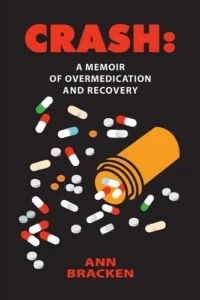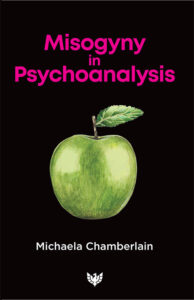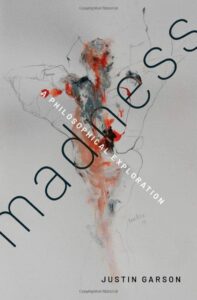Crash: A Memoir of Overmedication and Recovery by Ann Bracken (Charing Cross Press)

“Have you ever done everything a doctor told you, only to find yourself sicker than before you began treatment?”
So asks Bracken in the first paragraph of her memoir, a devastatingly honest, ultimately hopeful account of personal and family anguish marked by crashes both literal and figurative. She zips back and forth in time, describing both her mother’s decades in the system and her own long arc of anguish and recovery—and touching on her daughter’s story as well.
The multigenerational saga begins in 1959, with her mother’s hospitalization for depression, and cycles through a decades-long ordeal that led to 37 ECT sessions (with minimal anesthesia) and psych drug upon psych drug upon psych drug. As a kid, Bracken had questions (where’s mom? why are the grownups whispering?); as an adult, she found answers in 30 years’ worth of medical documents meticulously preserved by her father.
The revelations were many. A full list of Helen Dempsey’s meds in the appendix includes barbiturates. Amphetamines. Tranquilizers. Antidepressants. The benzodiazepine Dalmane. The anticonvulsant Dilantin. Beyond all those medications and ECT, Dempsey also received some talk therapy—“but I’m not sure how helpful it was for my mother to talk with her male psychiatrists,” Bracken writes, “especially given the medical establishment and cultural attitudes toward women at the time.”
Understanding her mother’s history became critical in understanding her own grappling with psychiatric harm, which began in 1993 with an intractable migraine and a descent into suicidal depression. We learn of her own sessions of ECT, her own hospitalizations, her own providers who failed to listen, and her own long list of meds, featured in the appendix below her mother’s. Benzos are on it. Antidepressants. Mood regulators. Opioids. Beta blockers. Headache drugs. When the headaches worsened, steroids. For anxiety, the antihistamine Vistaril. The list goes on.
At one point, meeting with her psychiatrist, she tells him: “I feel like a chemical waste dump.” After explaining why, he instructs her to hang on. After telling him she’s sick of being told to hang on while “all of the ECT, all of the pills” fail to help her, he puts her on Depakote. Yet another pill. Of course.
These and other interactions with psychiatry are equal parts infuriating and heart-wrenching. So are accounts of her ex-husband’s emotional abuse as he angrily disparaged, even mocked, her struggles and informed her she’d never be well. Such tales draw out the injustice and futility in pathologizing and medicating human experience, and the need—the imperative—to listen to that experience with curiosity and compassion.
Bracken found the latter, at last, with an energy healer who eased her pain and helped her taper. She ends her book with a call for change, making the case for fully informed consent: At the very least, doctors need to be genuine sources of drug information for their patients. “And we must demand it,” she writes.
*****
Misogyny in Psychoanalysis by Michaela Chamberlain (Phoenix Publishing House)
 Psychoanalysis could sure use some psychoanalysis: That’s the chief takeaway from Chamberlain’s book, which is as adamant and inarguable as it is slim. She does not mince words in breaking down the mansplained misconstructions of womanhood that define the core tenets of Freudian psychoanalysis and influence practice and institutions to this day. Even now, women too often feel unseen and unheard. (See Ann Bracken’s memoir, above.)
Psychoanalysis could sure use some psychoanalysis: That’s the chief takeaway from Chamberlain’s book, which is as adamant and inarguable as it is slim. She does not mince words in breaking down the mansplained misconstructions of womanhood that define the core tenets of Freudian psychoanalysis and influence practice and institutions to this day. Even now, women too often feel unseen and unheard. (See Ann Bracken’s memoir, above.)
But naming a wrong, pointing at it and voicing outrage, is the first step in correcting it. Scriptures must be challenged, sometimes, with scrutiny. And this tiny book is one fiercely articulated rejoinder, a concise but complete critique of the assumptions behind the theorizing—and the male-dominated power structure that endures to this day.
“In all the groups I have been a part of, a divide has taken place between those who ‘get’ Freud and those who do not,” writes Chamberlain, reflecting on her years in the field. Finally, the reason for the divide became clear: “Rarely did the men find Freud off-putting or difficult to read, whilst the women would huddle to share notes and become anxious to make sense of the readings. It was at this point that it became apparent to me that I struggled with Freud because it was never written for me, it was written by a man for men.”
Consider the Oedipus complex and the associated concept of penis envy: For Freud and his followers, female sexual organs and psychology had built-in deficits. They simply weren’t enough. Women and girls were bound to feel incomplete, bound to feel castrated and frustrated, bound to yearn for something they never had. From the start, Chamberlain explains, Freud considered it “almost a ‘no go’ area for disagreement,” shunting aside any and all dissenting voices—female analysts included—from his inner circle.
Chamberlain, a UK-trained and -based psychoanalyst, doesn’t limit her arguments to theory: At various points, she delves into feminist performance art (Marina Abramović’s “Rhythm 0”) and music (Cardi B and Megan Thee Stallion’s “WAP”) that highlight and challenge misogynistic norms. Her aim is broad, her examples bold, and the general readership will grasp every point she makes. But the author wants her colleagues to grasp them, too—with the understanding that most women who point out misogyny in the ranks are eventually, inevitably discounted.
Because of what? Misogyny. It’s a closed loop, and generationally ingrained habits in how women are seen or not, how they’re heard or not, are tough to shake.
“There is something shameful in the history of psychoanalysis which needs to be acknowledged. But it seems that there is a paralysis in this move to acknowledgement, as the real shame is in the fact that the misogyny is not historical, it is present,” she writes, “and holds back true development. . . . It feels that psychoanalysis is caught in that same loop of repetition, too afraid to allow itself to be properly analysed and live with that part of itself.” Psychoanalysis is, as a result, a “boys club” that “maintains the benefits of white middle-class male privilege.”
The baseline question that needs to be asked: Why? Why hasn’t the contemporary practice of psychoanalysis “stepped outside its comfort zone and addressed its own insecurity? Rather than hiving off gender and sexual equality as a specialist subject, psychoanalysis needs to address its own misogyny.”
Let the shrinking begin.
*****
Madness: A Philosophical Exploration by Justin Garson (Oxford University Press)
 Is someone whose thoughts and feelings take a strange turn deranged and disordered? Or are they instituting some tactic, some way forward, on their quest to make do and find meaning? Is there a reason behind their madness? Is there perhaps some innate design?
Is someone whose thoughts and feelings take a strange turn deranged and disordered? Or are they instituting some tactic, some way forward, on their quest to make do and find meaning? Is there a reason behind their madness? Is there perhaps some innate design?
These are, quite literally, questions for the ages, and Garson tackles them all—and more—with a thoroughness, a calm and inclusive meticulousness, that impresses while it persuades. As he explains from the outset and unpacks at length, conceptions of madness mostly fall into one of two broad philosophical camps. On one side, madness is viewed through the lens of teleology—that is, as having purpose. On the other, it’s seen through the lens of dysteleology—that is, lacking purpose.
Madness covers several millennia’s worth of examples, from the mages, magicians, and Christians who considered madness an act of the gods or God; to the followers of Hippocrates, who blamed some clogged airflow or malfunctioning humor; to Kant, who saw failures in mental faculties; to Freud, who saw subliminal intent; to 19th-century physician Arthur Wigan, who considered the mind as dual and madness as inherent; to others who saw striving, problem-solving, and flights from a painful world; to the Diagnostic and Statistical Manual and the mid-20th-century shift from dysteleology to teleology; to the emergence of Darwinian medicine, which can view madness as both evolutionary disorder and adaptation.
To be clear: The above distillation barely scratches the surface of Garson’s book. On the topic of madness there are endless takes, expostulations, and theories, far too many to tick off here. As the author says in his own introduction, “An overview of this sort is bound to be far too condensed, too abbreviated, to serve as a working road map.”
But his intro sets the tone for the book that follows, which serves as both a deep-dive history of changing attitudes and a call to consider that history, and those attitudes, as dissenting schools of thought. Either madness makes sense, or it’s senseless. Either the mad are purposeful, or they’re patients. Either depression, anxiety, and psychosis serve a function—some coping mechanism, some watchfulness against uncertainty, some flight from a devastating world—or they need to be fixed. Corrected. Treated. In a pharma model, medicated.
Garson, a professor of philosophy at Hunter College and the City University of New York’s Graduate Center, is also the author of The Biological Mind: A Philosophical Introduction and other works exploring the intersections of brain and body. His new volume is a bit of an investment, retailing for around $60 (paper copy) or $55 (ebook), not abnormal for chunky tomes aimed primarily at academia. Which is a shame, because Garson’s book is wholly get-able. It’s also wholly relevant for anyone concerned about the disease paradigm and curious about the twists in thinking that brought us here.
In his epilogue, the author ponders another massive philosophical pickle: Are we actually mad by default? Cycling back to Wigan’s view of madness as unremarkable for a divided brain, Garson wonders whether “sanity itself is a thing that is surprising and remarkable”—the exception to the rule.
“The starting point for future philosophical inquiry,” he concludes, “is not: what is madness? What shall we compare it to? But rather: what is sanity? What shall we compare it to?”
Yet more questions for the ages. I look forward to reading his answers.
****
MIA Reports are supported, in part, by a grant from The Thomas Jobe Fund.





The image chosen for this article is entirely inappropriate.
Report comment
I am curious. Why do you think the image is inappropriate? I did not think much of it.
Report comment
I found the person’s image somewhat distracting.
Report comment
I see. I usually ignore all images on this website and go straight to the texts.
Report comment
Amy, thanks a lot for your review! I may read them soon!
Report comment
So glad there’s finally a book that addresses (concisely) the rank misogyny that permeates psychiatry. I can’t wait to read it!
But it’s no surprise, because in my opinion, psychiatry IS misogyny, through and through. Always has been, always will be. It’s the indisputable junk-heap of unconscious male insecurity.
And why is there so much misogyny in psychiatry? Because the men who devised it (unbeknownst to themselves) thought with their crotchets. No surprise there! And most male psychiatrists still do, (again, unbeknownst to themselves), as facing the unreality of their unconsciously presumed superiority is their unconscious terror. It’s as simple and as stupid as that.
And as the saying goes, you get what you pay for, which for most women “patients” means more of the same unconscious misogyny they already experience from their husbands, fathers, sons, bosses, or even from those men who happen to work under them. It’s as predictable as a man’s unimpeded farts and other bodily odors – –
Report comment
Correction: “Why is there so much misogyny in psychiatry? Because the men who devised it thought with their CROTCHES”, not ‘crotchets’.
And I was referencing the book, “Misogyny in Psychoanalysis”, by Michaela Chamberlain, which seems well worth reading.
And the other two books reviewed sound like real doozies, too. Especially the first one, “Crash: A Memoir of Overmedication and Recovery” by Ann Bracken, especially for things like, “I’m not sure how helpful it was for my mother to talk with her male psychiatrists….especially given the medical establishment and cultural attitudes towards women at that time.” Very important insight, but I don’t think things have changed very much. And as for Ms. Bracken revealing to her psychiatrist that “she feels like a chemical waste dump”, and he prescribes “Yet another pill. Of course.” THAT’S psychiatry in a nutshell, and proves that being a psychiatrist is essentially no different than than being a street dealer.
And while the last book, “Madness: A Philosophical Exploration” by Justin Garson sounds interesting, especially with its no-stone-unturned approach, I’m less enthusiastic, as I’ve little patience for the meanderings of yet another academic, no matter how enlightened or informative s/he may be. And at the risk of sounding cynical, I can imagine (most) psychiatrists—being the hustlers they are—will find a way to either dismiss it or co-opt it, like everything else.
And btw, I don’t consider myself a feminist. I just call things as I see them and let the chips fall where they may.
Report comment
I’ve little patience for the philosophical meanderings of yet another mumbling, fumbling, incurably pasty-faced academic whose ponderous intellectual wandering (i.e. farting around) does little to improve the situation at hand, while (most) psychiatrists and other “mental health professionals” manage to get off scott free.
And I’m a “shit or get off the pot” kind of person AND AM DAMN PROUD OF IT —
Report comment
Ms. Biancolli quotes Mr. Garson: “The starting point for future philosophical inquiry is not: what is madness? What shall we compare it to? But rather: what is sanity? What shall we compare it to?”
With all due respect, I’d rather stick with the first question: what is madness?
And that I can answer in three letters: DSM. It’s the very definition of madness—PSYCHIATRY’S MADNESS. And deception. And arrogance. And cruelty. And ugliness. And stupidity. And evil. AND GREED.
Things in “mental health system” have reached a point that asking the unanswerable is pointless. It’s become a matter of people’s basic human and civil rights being seriously violated, which psychiatry does almost gleefully and with little to no regard for the potentially disastrous consequences in the lives of living, breathing, thinking, and definitely FEELING people.
Philosophical debate will not and cannot stop the problems created and denied by the out-of-control mental health industry which is headed by the two-headed juggernaut of psychiatry and its partners in crime, the pharmaceutical industry. The only thing that can possibly stop, or at least curtail, the disease of psychiatry is a massive public outcry against psychiatry’s discriminatory “diagnoses” and its debilitating “drugs”. And it definitely needs more and bigger victories in court. But no one should count on the latter. But one thing is certain: change can only happen when enough lives are ruined or lost as a result of psychiatry’s egregious misrepresentations of “disease” and its debilitating “drugs”. And tragically, this process is well underway —
Report comment
Removed for moderation.
Report comment
I wish someone would do a review of Steven James Bartlett’s book “Normality Does Not Equal Mental Health: The Need to Look Elsewhere for Standards of Good Psychological Health”
I find it hard to believe no author in MIA has not heard of this book. I sent a copy to Robert Whitaker years ago hoping he would do a review but to no avail.
Report comment
Based on the title, I’m guessing we’d agree about a lot of things!
Report comment
That sounds like it would be a great one to read alongside Gabor Maté’s “The Myth of Normal”, which I’ve recently begun listening to as an audiobook. Thank you very much for mentioning the book here!
Report comment
I agree, Crimson. I have yet to get Mate’s book. I’ve watched many of his past lectures online. He means a lot to me as well.
Report comment